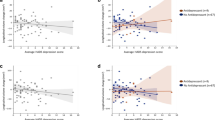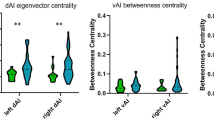Abstract
Depression is a common occurrence in patients with Parkinson's disease (PD); however, its pathophysiology is still unclear. This study assessed the association between the integrity of white matter and depressive symptoms in patients with PD. 67 patients with PD were divided into a non-depressed PD group (ndPD, n = 30) and a depressed PD group (dPD, n = 37). The dPD group was further subdivided into a mild-moderately depressed PD (mdPD, n = 22) and a severely depressed PD group (sdPD, n = 15). Tract-Based Spatial Statistics was used to compare fractional anisotropy (FA) between groups. Region-of-interest analysis was used to explore changes in diffusivity indices in the regions showing FA abnormalities. The sdPD patients exhibited significantly reduced FA in the left superior longitudinal fasciculus, uncinate fasciculus, anterior corona radiata, corticospinal tract, and bilateral inferior fronto-occipital fasciculus when compared with the ndPD patients, but the decreased FA was within a smaller area when compared with the mdPD patients. No significant difference in FA was found between the mdPD and ndPD groups. Among the dPD patients, FA values in the left superior longitudinal fasciculus negatively correlated with BDI scores. Impaired white matter integrity in the prefronto-limbic/temporal circuitry, mainly in the left hemisphere, is associated with severe, but not mild-moderate depressive symptoms in patients with PD.


Similar content being viewed by others
Abbreviations
- PD:
-
Parkinson’s disease
- WM:
-
White matter
- BDI:
-
21-Item Beck’s Depression Inventory
- ndPD:
-
Non-depressed patients with PD
- dPD:
-
Depressed patients with PD
- mdPD:
-
Mild-moderately depressed patients with PD
- sdPD:
-
Severely depressed patients with PD
- DTI:
-
Diffusion tensor imaging
- TBSS:
-
Tract-Based Spatial Statistics
- FA:
-
Fractional anisotropy
- AD:
-
Axial diffusivity
- RD:
-
Radial diffusivity
- MD:
-
Mean diffusivity
- ROI:
-
Region of interest
- UF:
-
Uncinate fasciculus
- IFOF:
-
Inferior fronto-occipital fasciculus
- SLF:
-
Superior longitudinal fasciculus
- ACR:
-
Anterior corona radiata
- CST:
-
Corticospinal tract
- MDD:
-
Major depressive disorder
- PET:
-
Positron emission tomography
- fMRI:
-
Functional magnetic resonance imaging
- UPDRS-III:
-
The motor part of the Unified Parkinson’s Disease Rating Scale
- H-Y:
-
Hoehn & Yahr
- CDR:
-
Clinical Dementia Rating scale
- MMSE:
-
The Mini Mental State Exam
- FSL:
-
FMRI software library
- FWE:
-
Family-wise error
- JHU:
-
John Hopkins University
- TFCE:
-
Threshold-free cluster-enhancement
- DLPFC:
-
Dorsolateral prefrontal cortex
References
Ansari, M., Adib, M. S., Ghazi, S. F., et al. (2019). Comparison of structural connectivity in Parkinson’s disease with depressive symptoms versus non-depressed: A diffusion MRI connectometry study. International Psychogeriatrics, 31(1), 5–12.
Chagas, M., Linares, M. P., Garcia, G. J., et al. (2013). Neuroimaging of depression in Parkinson’s disease: A review. International Psychogeriatrics, 25, 1953–1961.
Chagas, M., Tumas, V., Pena-Pereira, M. A., et al. (2017). Neuroimaging of major depression in Parkinson’s disease: Cortical thickness, cortical and subcortical volume, and spectroscopy findings. Journal of Psychiatric Research, 90, 40–45.
Cole, J., Chaddock, C. A., Farmer, A. E., et al. (2012). White matter abnormalities and illness severity in major depressive disorder. The British Journal of Psychiatry, 201, 33–39.
Diwadkar, V. A., Bellani, M., Chowdury, A., et al. (2018). Activations in gray and white matter are modulated by uni-manual responses during within and inter-hemispheric transfer: Effects of response hand and right-handedness. Brain Imaging and Behavior, 12(4), 942–961.
Ghazi, S. F., Rahmani, F., Jooyandeh, S. M., et al. (2018a). Microstructural changes in patients with Parkinson disease and REM sleep behavior disorder: Depressive symptoms versus non-depressed. Acta Neurologica Belgica, 118(3), 415–421.
Ghazi, S. F., Rostam, A. Y., Mojtahed, Z. M., et al. (2018b). Microstructural changes in patients with Parkinson’s disease comorbid with REM sleep behaviour disorder and depressive symptoms. Frontiers in Neurology, 9, 441.
Gou, L. B., Zhang, W., Li, C. M., et al. (2018). Structural brain network alteration and its correlation with structural impairments in patients with depression in de novo and drug-naive Parkinson’s disease. Frontiers in Neurology, 9, 608.
Hau, J., Sarubbo, S., Perchey, G., et al. (2016). Cortical terminations of the inferior fronto-occipital and uncinate fasciculi: Anatomical stem-based virtual dissection. Frontiers in Neuroanatomy, 10, 58.
Huang, P., Xu, X., Gu, Q., et al. (2014). Disrupted white matter integrity in depressed versus non-depressed Parkinson’s disease patients: A tract-based spatial statistics study. Journal of the Neurological Sciences, 346, 145–148.
Koenigs, M., & Grafman, J. (2009). The functional neuroanatomy of depression: Distinct roles for ventromedial and dorsolateral prefrontal cortex. Behavioural Brain Research, 201, 239–243.
Li, H., Jia, J., & Yang, Z. (2016). Mini-mental state examination in elderly Chinese: A population-based normative study. Journal of Alzheimer’s Disease, 53, 487–496.
Li, W., Liu, J., Skidmore, F., et al. (2010). White matter microstructure changes in the thalamus in Parkinson disease with depression: A diffusion tensor MR imaging study. AJNR American Journal of Neuroradiology, 31, 1861–1866.
Liao, Y., Huang, X., Wu, Q., et al. (2013). Is depression a disconnection syndrome? Meta-analysis of diffusion tensor imaging studies in patients with MDD. Journal of Psychiatry & Neuroscience, 38, 49–56.
Lou, Y., Huang, P., Li, D., et al. (2015). Altered brain network centrality in depressed Parkinson’s disease patients. Movement Disorders, 30, 1777–1784.
Matsui, H., Nishinaka, K., Oda, M., et al. (2007). Depression in Parkinson’s disease. Diffusion tensor imaging study. Journal of Neurology, 254, 1170–1173. https://doi.org/10.1007/s00415-006-0236-6
Schapira, A., Chaudhuri, K. R., & Jenner, P. (2017). Non-motor features of Parkinson disease. Nature Reviews Neuroscience, 18, 435–450.
Schmahmann, J. D., Pandya, D. N., Wang, R., et al. (2007). Association fibre pathways of the brain parallel observations from diffusion spectrum imaging and autoradiography. Brain, 130, 630–653.
Smith, S. M. (2002). Fast robust automated brain extraction. Human Brain Mapping, 17, 143–155.
Smith, S. M., Johansen-Berg, H., Jenkinson, M., et al. (2007). Acquisition and voxelwise analysis of multi-subject diffusion data with tract-based spatial statistics. Nature Protocols, 2, 499–503.
Smith, S. M., Jenkinson, M., Woolrich, M. W., et al. (2004). Advances in functional and structural MR image analysis and implementation as FSL. Neuroimage, 23(Suppl 1), S208-219.
Song, S. K., Sun, S. W., Ramsbottom, M. J., et al. (2002). Dysmyelination revealed through MRI as increased radial (but Unchanged Axial) diffusion of water. NeuroImage, 17, 1429–1436.
Sterling, N., Du, G., Lewis, M., et al. (2017). Cortical gray & subcortical white matter associations in Parkinson’s disease. Neurobiology of Aging, 49, 100–108.
Surdhar, I., Gee, M., Bouchard, T., et al. (2012). Intact limbic-prefrontal connections and reduced amygdala volumes in Parkinson’s disease with mild depressive symptoms. Parkinsonism & Related Disorders, 18, 809–813.
Thobois, S., Prange, S., Sgambato-Faure, V., et al. (2017). Imaging the etiology of apathy, anxiety, and depression in Parkinson’s disease: Implication for treatment. Current Neurology and Neuroscience Reports, 17, 76.
Torbey, E., Pachana, N. A., & Dissanayaka, N. N. (2015). Depression rating scales in Parkinson’s disease: A critical review updating recent literature. Journal of Affective Disorders, 184, 216–224.
van Mierlo, T. J., Chung, C., Foncke, E. M., et al. (2015). Depressive symptoms in Parkinson’s disease are related to decreased hippocampus and amygdala volume. Movement Disorders, 30, 245–252.
Wen, M. C., Chan, L. L., Tan, L. C., et al. (2016). Depression, anxiety, and apathy in Parkinson’s disease: Insights from neuroimaging studies. European Journal of Neurology, 23, 1001–1019.
Wu, F., Tang, Y., Xu, K., et al. (2011). Whiter matter abnormalities in medication-naive subjects with a single short-duration episode of major depressive disorder. Psychiatry Research, 191, 80–83.
Wu, J. Y., Zhang, Y., Wu, W. B., et al. (2018). Impaired long contact white matter fibers integrity is related to depression in Parkinson’s disease. CNS Neuroscience & Therapeutics, 24, 108–114.
Funding
This study was supported by the National Natural Science Foundation of China (81471646), the Science Foundation of Hunan Province (14JJ2027) and Clinical Research Center for Medical Imaging in Hunan Province (2020SK4001).
Author information
Authors and Affiliations
Corresponding author
Ethics declarations
Informed consent
Informed consent was obtained from all individual participants.
Research involving human participants
All procedures performed in this study were in accordance with the ethical standards of the Second Xiangya Hospital, Central South University.
Disclosure of potential conflicts of interest
All authors declared no potential conflict of interests.
Additional information
Publisher's note
Springer Nature remains neutral with regard to jurisdictional claims in published maps and institutional affiliations.
Supplementary Information
Below is the link to the electronic supplementary material.
11682_2021_488_MOESM1_ESM.png
Supplementary file1 (PNG 201 KB) Supplemental material Fig. 1. White matter regions with lower fractional anisotropy (FA) in sdPD than ndPD patients were analyzed by more detailed DTI measures. (A) FA was decreased in four clusters; (B) Radial diffusivity (RD) was increased in three clusters; (C) Axonal diffusivity (AD) was decreased in one cluster; (D) Mean diffusivity (MD) was increased in one cluster. The bars and whiskers represent mean values of the DTI metrics and standard deviations, respectively. Cluster 1: left superior longitudinal fasciculus, left anterior corona radiata, left uncinate fasciculi; cluster 2: right inferior fronto-occipital fasciculus (IFOF); cluster 3: left IFOF, left corticospinal tract; and cluster 4: right IFOF. *P < 0.05
11682_2021_488_MOESM2_ESM.png
Supplementary file2 (PNG 111 KB) Supplemental material Fig. 2. White matter regions with lower fractional anisotropy (FA) in sdPD than mdPD patients were analyzed by more detailed DTI measures. (A) FA was decreased in three clusters; (B) Radial diffusivity (RD) was increased in two clusters; (C) Axonal diffusivity (AD) showed no significant difference between the two groups; (D) Mean diffusivity (MD) was increased in one cluster. The bars and whiskers represent mean values of the DTI metrics and standard deviations, respectively. Cluster 1: left superior longitudinal fasciculus; cluster 2: right inferior fronto-occipital fasciculus (IFOF); and cluster 3: left uncinate fasciculi and left IFOF. *P < 0.05.
Rights and permissions
About this article
Cite this article
Shen, Q., Liu, Y., Guo, J. et al. Impaired white matter microstructure associated with severe depressive symptoms in patients with PD. Brain Imaging and Behavior 16, 169–175 (2022). https://doi.org/10.1007/s11682-021-00488-7
Accepted:
Published:
Issue Date:
DOI: https://doi.org/10.1007/s11682-021-00488-7




